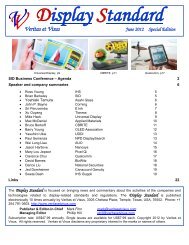You also want an ePaper? Increase the reach of your titles
YUMPU automatically turns print PDFs into web optimized ePapers that Google loves.
<strong>Veritas</strong> <strong>et</strong> <strong>Visus</strong> <strong>Display</strong> <strong>Standard</strong> February 2009<br />
By 2004, the notebook PC mark<strong>et</strong> had adopted the 16:10 aspect ratio as a general standard – standardized early on<br />
through the efforts of the <strong>Standard</strong> Panels Working Group (SPWG) at 12.1-, 14.1-, 15.4-, and 17.0-inches, all at a<br />
16:10 aspect ratio, at a vari<strong>et</strong>y of pixel formats – 1920x1200, 1680x1050, 1440x900, and 1280x800. Until recently,<br />
the vast majority of all notebook PCs are sold with wide aspect ratio displays, and most all of them are at a 16:10<br />
aspect ratio.<br />
The notebook PC mark<strong>et</strong> transitioned from displays at a 4:3 aspect ratio to displays at a 16:10 aspect ratio – with<br />
experiments at various formats during the transition process. Interestingly, the geom<strong>et</strong>ry of the formats results in a<br />
situation where the smallest diagonal results in the largest total surface area.<br />
On October 21, 2008 Samsung announced plans to introduce LCD panels designed for notebook PCs at a 16:9<br />
aspect ratio. Samsung announced two versions, one at 16.0-inches and the other at 18.4-inches. According to the<br />
Samsung press release, “these new panels allow notebook users to optimally view high definition movies, digital<br />
TV and next-generation gaming, all of which were designed for a 16:9 aspect ratio”.<br />
16:10 vs. 16:9: Each of the primary LCD manufacturers has now introduced 16:9 panels for both the notebook PC<br />
and LCD monitor mark<strong>et</strong>s. The mark<strong>et</strong> research firm <strong>Display</strong>Search has been actively predicting a rapid transition<br />
from 16:10 panels to 16:9 panels. The <strong>Display</strong>Search analysis cites several “driving forces behind the fact that 16:9<br />
panels become more popular eventually”:<br />
� 16:9 provides b<strong>et</strong>ter economic cut (panelization) in existing TFT LCD fabs.<br />
� 16:9 products provide higher resolution and wider aspect ratio.<br />
� The widespread adoption of high definition in the consumer entertainment sector will help end users<br />
readily adopt the new products with the wider aspect ratio.<br />
� The new 16:9 panels provide an opportunity for PC brands to further diversify their products.<br />
Based on these explanations, <strong>Display</strong>Search has<br />
justified forecasts for a rapid transition to 16:9,<br />
as depicted in the transition charts to the right,<br />
(which <strong>Display</strong>Search presented in late 2008).<br />
While I very much respect the mark<strong>et</strong> research<br />
conducted by <strong>Display</strong>Search, I should point out<br />
that in the area of aspect ratios, the company<br />
does not have a good track record. In 2001, for<br />
example, <strong>Display</strong>Search was predicting that 1/3<br />
of the LCD TV mark<strong>et</strong> would still be shipping<br />
at 4:3 aspect ratios. (By 2004, virtually 100% of<br />
the mark<strong>et</strong> was at 16:9). Less than two years<br />
ago, <strong>Display</strong>Search was not predicting that<br />
notebook PCs or LCD monitors would be<br />
shifting to 16:9, and in fact they were<br />
comparatively bearish about the transition from<br />
4:3/5:4 to 16:10. (See charts from March 2007):<br />
<strong>Display</strong>Search’s predictions about the transition from 4:3 and<br />
5:4 panels, to 16:10, to 16:9 panels – notebooks on the left;<br />
monitors on the right.<br />
8






